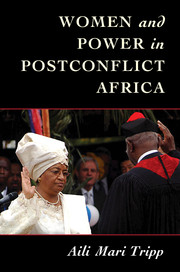Book contents
- Frontmatter
- Epigraph
- Dedication
- Contents
- List of Tables
- List of Figures
- Map of Africa
- List of Acronyms
- Acknowledgments
- Preface
- Part I Setting the Stage
- Part II Case Studies
- Part III New Openings for Women's Rights
- Part IV Gendered Outcomes
- 8 Women and Leadership in Postconflict Countries
- 9 Women's Rights and Postconflict Legislative Reform
- Part V Future Research
- References
- Index
8 - Women and Leadership in Postconflict Countries
from Part IV - Gendered Outcomes
Published online by Cambridge University Press: 05 November 2015
- Frontmatter
- Epigraph
- Dedication
- Contents
- List of Tables
- List of Figures
- Map of Africa
- List of Acronyms
- Acknowledgments
- Preface
- Part I Setting the Stage
- Part II Case Studies
- Part III New Openings for Women's Rights
- Part IV Gendered Outcomes
- 8 Women and Leadership in Postconflict Countries
- 9 Women's Rights and Postconflict Legislative Reform
- Part V Future Research
- References
- Index
Summary
The voice of women is the voice of the nation, let them be heard.
– Sign in Sierra Leone villageSince the early 1990s we have witnessed many important changes in Africa with respect to women's political engagement, especially in postconflict countries. These trends have been identified globally as well (Hughes 2009; Luciak 2006, 6; Zuckerman and Greenberg 2004, 71). Rwanda claimed the world's highest ratio of women in parliament in 2003, and in the subsequent election, Rwandan women became the first in the world to hold a majority of a country's national legislative seats (56%). By 2012, the figure jumped to 64 percent. The countries with the highest levels of legislative representation in Africa are almost entirely postconflict countries and they were among the first to adopt higher rates of representation. Moreover, it is no accident that postwar Liberia was the first African country to elect a woman president, Ellen Johnson Sirleaf, in 2005. Postconflict Uganda already had a woman vice president for a decade between 1993 and 2003. Five members of Sudan's postwar cabinet are women, a significant increase from the previous cabinet. Similar postwar patterns that catapulted women into leadership roles were evident in local government, in the judiciary, and in regional bodies throughout Africa.
This chapter connects the end of conflict to women's political representation, which is one of the more dramatic changes in postconflict countries. It looks not only at women's legislative representation, where the changes have been most striking, but also at other areas of leadership in the executive, at the local level and elsewhere. It shows how these patterns are related to the causal mechanisms described earlier in the book: disruptions in gender relations, rise of women's movements fueled by a modicum of political liberalization, and the changes in international norms and pressures. It also discusses some of the other factors that have been used to explain women's political representation.
Legislative representation
The changes in women's political representation in Africa have been most dramatic in legislatures, where female representation tripled between 1990 and 2010 (Figure 8.1). This changing sex ratio is most visible in postconflict countries in Africa, where women claim considerably more seats (29%) on average compared with other countries (16%).
- Type
- Chapter
- Information
- Women and Power in Postconflict Africa , pp. 193 - 217Publisher: Cambridge University PressPrint publication year: 2015



